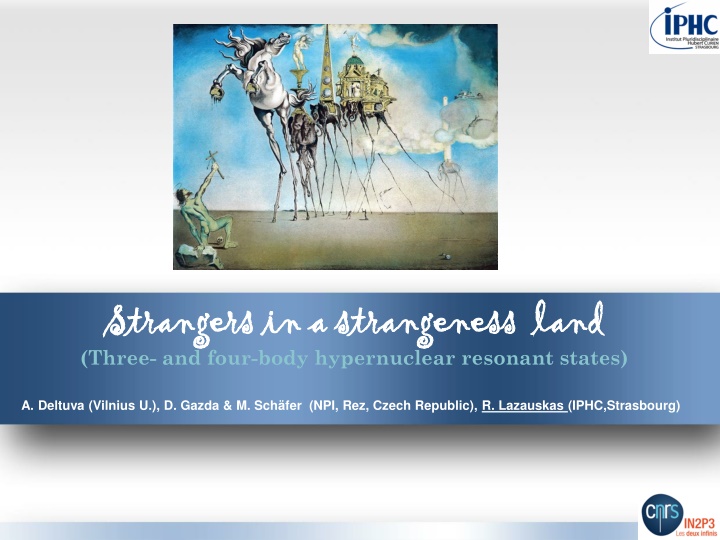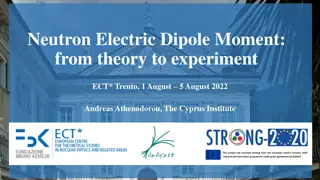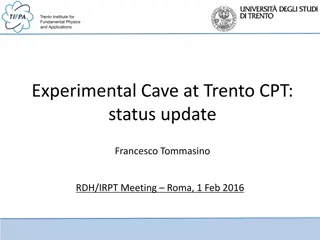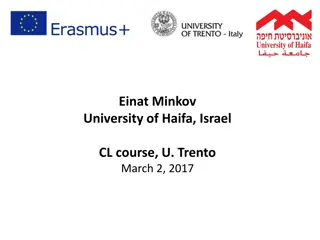
Bound Hypernuclei and Strange Particle Interactions
Explore the fascinating world of hypernuclei and strange particle interactions, including resonant states, separation energies, and hyperon-nucleon interactions. Learn about bound hypernuclei, 3-body systems, and the latest research in the field. Discover the complexities of strange particles and their interactions in this intriguing domain of physics.
Download Presentation

Please find below an Image/Link to download the presentation.
The content on the website is provided AS IS for your information and personal use only. It may not be sold, licensed, or shared on other websites without obtaining consent from the author. If you encounter any issues during the download, it is possible that the publisher has removed the file from their server.
You are allowed to download the files provided on this website for personal or commercial use, subject to the condition that they are used lawfully. All files are the property of their respective owners.
The content on the website is provided AS IS for your information and personal use only. It may not be sold, licensed, or shared on other websites without obtaining consent from the author.
E N D
Presentation Transcript
Strangers Strangers in a (Three- and four-body hypernuclear resonant states) in a strangeness strangeness land land A. Deltuva (Vilnius U.), D. Gazda & M. Sch fer (NPI, Rez, Czech Republic), R. Lazauskas (IPHC,Strasbourg)
Strange particles (hyperons) + d d u u +80 MeV +165 MeV n p A.Deltuva, D. Gazda, M. Sch fer & RL
Hyperon-nucleon interaction Z=- -1 1 Z=0 Z=0 Z= Z=1 Z=1 Z=2 Z=2 +n +p +n +p No 2-body bound states. 36 low-energy data points ++n ++p +n +p J. Haidenbauer et al., Eur. Phys. J. A (2020) 56-91 A.Deltuva, D. Gazda, M. Sch fer & RL
Hyperon-nucleon interaction Z=- -1 1 Z=0 Z=0 Z= Z=1 Z=1 Z=2 Z=2 +n +p +n +p ++n ++p +n +p J. Haidenbauer et al., Eur. Phys. J. A 56 (2020) 91 A.Deltuva, D. Gazda, M. Sch fer & RL
Bound hypernuclei Table 4.The separation energies of the most loosely bound particles in the light hypernuclei. The excitation energies lower than those in column 4 lead to -decaying states. The last column shows the lightest of the possible targets which may be used for production of a given hypernucleus. Based on the most recent data of the European K - Collaboration [1]. separation energies: expected number of gamma;- decaying states most loosely bound particles separatio n energies (MeV) hypernuc lei residual parts lightest targets S-shell 3H 2H 0.13 0.05 1 ? (3He) 4H 3H 2.04 0.04 1 4He 4He 3He 2.39 0.03 1 J. Haidenbauer et al., Few-Body Syst. 62 (2021) 105 5He 4He 3.12 0.02 - 6Li P-shell 6He n 5He 0.17 0.10 1 ? 7He n 6He 3.0 ? 2 7Li 7Li d 5He 3.93 0.04 4 7Be 2p 5He 0.67 0.08 - 9Be 8He n 7He 1.5 ? 1 ? 8Li t 5He 6.15 0.04 5 5Be 3He 5He 5.31 0.06 5 9Li n 8Li 3.76 0.16 manyx) 9Be 5He 3.50 0.04 2 1.18 0.16 c 9B p 8Be 3 10B 10Be n 9Be 4.25 0.26 many 10B p 9Be 1.99 0.13 3 11B p 10Be 7.53 0.27 many 11B 11.37 0.0 6 9.8 12B 11B many 12C 12C 11B many A.Deltuva, D. Gazda, M. Sch fer & RL
3-body systems Z=0 Z=0 Z= Z=- -1 1 Z=1 Z=1 Z=2 Z=2 +pn +pp +nn +2H +nn +pn +pp ++pn Z=3 Z=3 ++nn +2H ++2H +nn ++pp +np +2H +pp 2H Experimentally B=0.164(43)+2.225 MeV No indication for a presence of bound or resonant Z=-1 or Z=3 states (A. Stadler, B.F. Gibson, PRC 50(1994) 512 ) only ( 3? ) state is well established with A.Deltuva, D. Gazda, M. Sch fer & RL
3-body systems Z=1 Z=1 Z=2 Z=2 Z=0 Z=0 +pn +pp +2H +pn +nn +pp ++pn ++nn +2H ? ++2H ? ? +nn +np +2H +pp Consensus that 0nn/ 0pp are not bound: R. H. Dalitz, Phys. Rev. 114, 593, 1959; . H. Garcilazo, J. Phys. G: Nucl. Phys. 13, 63, 1987; K. Miyagawa et al., Phys. Rev. C 51, 2905, 1995; H. Garcilazo et al., Phys. Rev. C 76, 034001, 2007; E. Hiyama et al., Phys. Rev. C 89, 061302(R), 2014. A. Gal, Phys. Lett. B 736, 93, 2014; M. Sch fer et al., Phys. Rev. C 103, 025204, 2021. Ongoing debate about resonant nn & NN states in Z=0 & Z=2 compounds V. B. Belyaev et al., Nucl. Phys. A 803, 210, 2008; I. R. Afnan, B. F. Gibson, Phys. Rev. C 92, 054608, 2015, M. Schafer et al., Phys. Lett. B 808 (2020) 135614 A.Deltuva, D. Gazda, M. Sch fer & RL
4-body systems There are clearly no states for Z=-1 ( nnn) and Z=4 ( +ppp) systems Some hope for Z=0 & Z=3 Feschbach resonant states in ( 0nnn,..) & ( 0ppp,..) Presence of well established 4? and? 4?e bound states Z=1 Z=1 Z=2 Z=2 ++nnn +2H+n +2H+p ++2H+n +3He ++3H +3He +3H ? +nnp +2H+n T. Nagae et al., Phys.Rev.Lett.80 (1998)1605 H. Outa et al., Prog. Theor. Phys. Suppl. 117 (1994) 177; R.S. Hayano et al., Phys. Lett. B 231 (1989) 355 +npp +2H+p +3H J?= 1+ +3He J?= 0+ A.Deltuva, D. Gazda, M. Sch fer & RL
Formalism When particle (3) flies away When particle (3) flies away ?13 0 & ?23 0; as a consequence ?13 0 & ?23 0, thus ? ???. 3-body (Faddeev eq.) 4-body (Faddeev-Yakubovsky eq.) 2 2 1 1 i i j j j j i i 3 3 k k l l k k ?12= ?0?12 l l 3 3 2 2 1 1 H-type (6 components) K-type (12 components) ?23= ?0?23 ???= ?0??? 3 3 1 1 2 2 ? ??= ????????? ???,? = ?????????+ ???; ??? ?31= ?0?31 = ?12+ ?23+ ?31 ? ?+ ??? ??) = ???= (???,? +???,? ?<? ?<? Equations for short-ranged pairwise interactions A.Deltuva, D. Gazda, M. Sch fer & RL
Formalism 3 Protons, neutrons and hyperons considered to particles 4 coupled-sets, for ( + )+ of 18 FY equations are solved 3 2 ? 2 ? be different ? ? 4 4 ? ? 4 12,3 34 K ?12 1 1 Partial wave expansion to express angular dependence of FY components ??, ? ? ???,??,?? ?????? Lagrange-mesh method to express radial dependence??, ? ? ???,??,?? and impose proper boundary conditions (D. Baye, Physics Reports 565 (2015)1) Iterative linear algebra methods to solve resulting large scale problem of linear equations Resonance positions might be found directly by applying complex-scaling method (R. Lazauskas, arXiv:1904.04675 ) ??( ??, ??, ??) = {Y ? ?? Y ? ??} ?? Y ? ?? L ?? ?? arXiv:1904.04675 Alternatively resonances in 3-body system are studied by AD solving AGS equations, and analyzing obtained collision amplitudes. A.Deltuva, D. Gazda, M. Sch fer & RL
3? b.s. 3-body system, test Z=1 Z=1 YN int. This work Ref. LO550 -2.349 -2.35 LO600 -2.343 -2.34 LO650 -2.343 -2.34 LO700 -2.362 -2.36 +pp +pn YN int. 2013 This work Ref. NLO450 -2.391 -2.39 NLO550 -2.299 -2.30 NLO650 -2.298 -2.30 ++nn +2H +np +2H Using Idaho EFT N3LO NN interaction D.R. Entem et al., Phys. Rev. C 68 (2003) 041001. Different YN EFT models from J. Haidenbauer et al., Few-Body Syst. 62 (2021) 105, Eur. Phys. J. A (2020) 56-91 A.Deltuva, D. Gazda, M. Sch fer & RL
3-body systems Z=1 Z=1 +pp Model dependence of ? ?? total cross section for ??= ?/?+PW +pn ++nn +2H +np +2H A.Deltuva, D. Gazda, M. Sch fer & RL
3-body system Z=1, ? = 1/2+state 0? 0? ? 0? 0? ? ?11 ?12 ?13 ?12 ??22 ??23 ?13 ??23 ??33 Z=1 Z=1 ???(?) = +pp idem for ( 0?, 0?, +?) +pn ++nn +2H Preliminary +np +2H Using Idaho EFT N3LO NN interaction D.R. Entem et al., Phys. Rev. C 68 (2003) 041001. Different YN EFT models from J. Haidenbauer et al., Few-Body Syst. 62 (2021) 105, Eur. Phys. J. A (2020) 56-91 A.Deltuva, D. Gazda, M. Sch fer & RL
3-body systems Z=2 Z=2 Z=0 Z=0 +pn +2H +nn +pp ++pn ? ++2H ? +nn +pp A.Deltuva, D. Gazda, M. Sch fer & RL
3-body system Z=2, ? = 1/2+state Z=2 Z=2 0? 0? ? 0? 0? ? ?11 ?12 ?13 ?12 ??22 ??23 ?13 ??23 ??33 ???(?) = idem for ( 0?, 0?, +?) +pp ++pn +d +np ++2H 1 NLO19 =500 MeV NLO19 =700 MeV LO =550 MeV LO =700 MeV 1. ? 0 1. +pp 1.45 1.35 Preliminary 1. Ei (MeV) 1.35 -1 1.3 1.35 1.15 1.45 -2 1.35 1.45 -3 69 70 71 72 73 74 75 76 ER (MeV) A.Deltuva, D. Gazda, M. Sch fer & RL
3-body systems (based on NLO700 (2019)) Z=0 Z=0 Z=2 Z=2 Z=1 Z=1 +pn +pp ? +2H +nn +pn +pp ++pn ++nn +2H ++2H +nn +np +2H +pp ??(? = 1.15) = 76.65 1.27? MeV ??= 74.09 0.79? MeV ??= 75.06 1.63? MeV Using Idaho EFT N3LO NN interaction D.R. Entem et al., Phys. Rev. C 68 (2003) 041001. Different YN EFT models from J. Haidenbauer et al., Few-Body Syst. 62 (2021) 105, Eur. Phys. J. A (2020) 56-91 A.Deltuva, D. Gazda, M. Sch fer & RL
3-body system observability of the J=1/2+ resonances? +2H Z=1 Z=1 1 E d(MeV) +pp 0 -5 -4 -3 -2 -1 0 1 -1 +pn ++nn +2H -2 -3 +np +2H 0.2 0.1 k d(fm-1) 0.0 -0.1 0.0 A.Deltuva, D. Gazda, M. Sch fer & RL
3-body system, Z=1 case primitive simulation of 3? ? ,? ? reaction Z=1 Z=1 Response function calculated assuming contact momentum independent fortm for ? ? ,? ??amplitude +pp 0,003 +pn ++nn +2H S (arb. units) 0,002 Preliminary +np +2H NLO700(2019) =1.3 =1.15 =1 0,001 0,000 50 60 70 Enp (MeV) A.Deltuva, D. Gazda, M. Sch fer & RL
3-body system, Z=1 case primitive simulation of 3? ? ,? ? reaction Z=1 Z=1 Response function calculated assuming contact momentum independent form for ? ? ,? ??amplitude +pp 0,002 +pn ++nn +2H S (arb. units) Preliminary 0,001 NLO700(2019) NLO500 LO700 LO550 +np +2H 0,000 50 60 70 Enp (MeV) A.Deltuva, D. Gazda, M. Sch fer & RL
3-body system, Z=2 case primitive simulation of 3?? ? ,? ? reaction Z=2 Z=2 Response function calculated assuming contact momentum independent form for ? ? ,? ??amplitude +d +pp ++pn 0.5 ++2H ? S (arb. units) Preliminary +pp 0.3 0.0 50 60 70 Epp (MeV) A.Deltuva, D. Gazda, M. Sch fer & RL
4-body systems Z=1 Z=1 Z=2 Z=2 ++nnn +2H+n +2H+p ++2H+n +3He ++3H +3He +3H +nnp +2H+n +npp +2H+p +3H J?= 1+ +3He J?= 0+ A.Deltuva, D. Gazda, M. Sch fer & RL
4-body systems ?= 0+(preliminary) Z=1 Z=1 Z=2 Z=2 ++nnn +2H+n +2H+p ++2H+n +3He +3He +3H ++3H Model E-E(????) E-E(???+) T. Nagae et al., Phys.Rev.Lett.80 (1998)1605 H. Outa et al., Prog. Theor. Phys. Suppl. 117 (1994) 177; R.S. Hayano et al., Phys. Lett. B 231 (1989) 355 LO550 LO700 NLO500 NLO700 -1.44-1.20i -1.39-1.53i -1.26-2.95i -2.28-2.85i -2.44-1.07i -3.30-1.60i -2.73-2.74i -3.83-2.67i A.Deltuva, D. Gazda, M. Sch fer & RL
3-body system, Z=1 case 0? 0? ? 0? 0? ? ?11 ?12 ?13 ?12 ??22 ??23 ?13 ??23 ??33 ???(?) 0+ ? 0+ ? = 300 LO =550 =1.2 250 idem for ( 0?, 0?, +?) NLO19 =700 =1.2 200 (mb) 150 + ? + ? 100 300 50 250 0 200 100 200 300 p (MeV) 400 500 600 700 (mb) 150 100 Not properly normalized! 50 Using Idaho EFT N3LO NN interaction D.R. Entem et al., Phys. Rev. C 68 (2003) 041001. Different YN EFT models from J. Haidenbauer et al., Few-Body Syst. 62 (2021) 105, Eur. Phys. J. A (2020) 56-91 0 120 130 140 150 160 170 180 p (MeV) A.Deltuva, D. Gazda, M. Sch fer & RL
Conclusions We have developped a code to study resonant states in 3- and 4- body hypernucleai, employing modern realistic interactions Possible existence of narrow ? = 1/2+Feschbach resonance states in the vicinity on states could be observed in (? ,? ) reactions on 2? + thresholds is suggested. These 3? and 3?? We confirm the existence of experimentaly observed ? = 0+ Feschbach resonance of 4??, as well as find similar 4? state We would like to thank J. Haidenbauer & A. Nogga for providing the YN interaction codes and helping in their implementation. Acknowledgements: We were granted access to the HPC resources of TGCC/IDRIS under the allocation 2023- AD010506006R2 made by GENCI (Grand Equipement National de Calcul Intensif).This work was supported by French IN2P3 for a theory project PUMA . A.Deltuva, D. Gazda, M. Sch fer & RL



